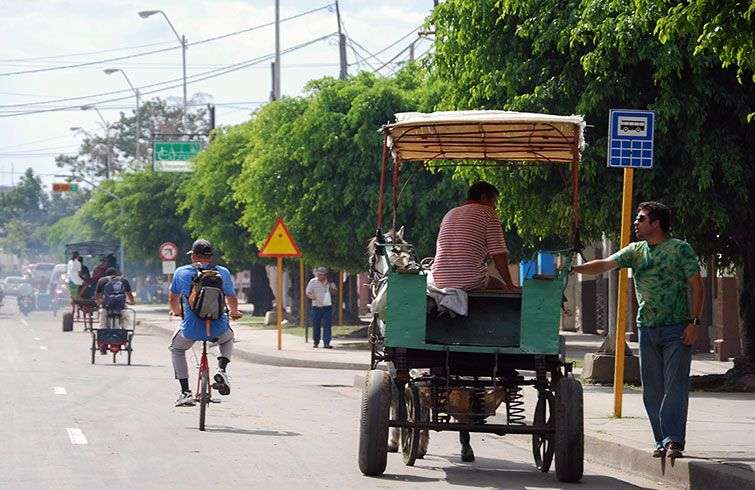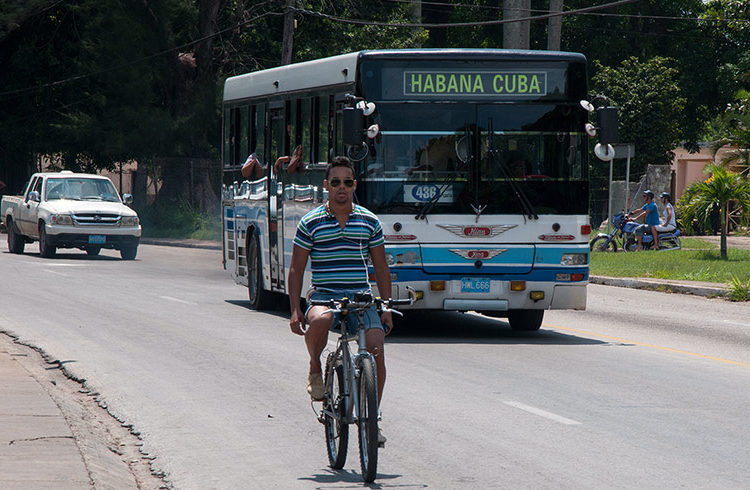There are few sectors in Cuba that have accumulated so much inefficiency for many years as the public transportation. Things didn’t work well even in the time of plenty, when Soviet aid was counted by billions and oil was paid with sugar.
Even the humor reflects this. Before Cuba entered the crisis of the 90s already a banner showed the painting of a Cuban bus packed with scenes of Guernica, Pablo Picasso´s painting representing chaos in a Basque village after the bombing of Nazi aviation.
Today, few believe that service will improve; recently a Cuban told me that he would invest everything he had into a “almendrón”, an American car of the 50s. Taxi “is business for sure, risk-free, because State transportation will never improve in Cuba, “he said.
In 2009 they spent $ 180 million on buses and director of provincial development, Carlos Gonzalez, said that “is a medium term plan for, in 2012, meet 85 percent of demand, that means carry more 3.5 million passengers a day.”It was one of many broken promises.
Based on the history of the last half century we have to accept that the Ministry can hardly organize transport well now if it was not able to do when they were all “socialist” buses it needed and advice from France, one of the most capable.

In more recent times, hundreds of buses were purchased in China but the ministry had requested that they had Caterpillar engines of American origin. Many of these vehicles are standing today for lack of spare parts, due to the US embargo against Cuba.
This decision is costing Cuba million because spare parts are bought through third countries and are more expensive and take longer to arrive. While the bus is standing in a warehouse where other parts are damaged or are “stolen” to be sold on the black market.
Industry officials also have not been able to minimally organize the private passenger transportation that is truly chaotic. Hundreds of vehicles in a deplorable technical condition with prices set by the market and routes and schedules determined by each driver.
In this ¨A Fondo¨ we tell you how a college student ended up with a wound on the forehead of 37 stitches when the van he was traveling lost direction and overturned, rolling over several times. It might seem an accident but maybe it could be avoided.
Technical failures in these cars are very common because they go through the annual check-up by paying under the table inspectors “not to see” the damage. With $ 20 in a bad shape car passes the “Somaton” as if it were a 0 km straight from the dealer.
However, we did not want to stay alone in the reality of transportation in Havana, so different from other cities such as Cienfuegos or Cárdenas where private horse-drawn carriages move more passengers than the scarce State buses.
But despite its social importance, the drivers complain that some local governments overwhelm them with little logic rules and inspectors persecute them daily with their fines. The situation has already led to strikes and protests in Bayamo, Santa Clara, Cardenas and Cienfuegos.
The government finally seems to have recognized the inability of the Ministry to manage transport companies, turned taxis and buses into cooperatives and tries now to test opening a bus terminal to foreign investment, including in the package the administration thereof.
In 2012 a deputy minister of transport said that “we’re working on many new things” but did not advance anything because “people do not deserve that we are announcing things that for one reason or another do not materialize later”. Two years later we can confirm he did well not to announce these improvements.












I believe that the most inefficient sector in Cuba in Cuba is the Military Junta, the regime. This sector is responsible for the whole destruction of almost all Cuban industries built by our people until 1959.……. Huge industries once leading the world producing sugar, construction materials, appliances, fish, sugar sub-products, construction, commerce, agricultural, cattle, etc disappeared in the last 56 years thanks the inefficient work of the regime in power……. This sector has been also responsible for the chaos and extreme malfunction of all other sectors in the economic, social and political areas including the health system that this regime inherited brand new in 1959, health system that 56 years later is in ruins….. and, of course, including regime’s failure in democratizing the country what was the initial project of the today non existing revolution.